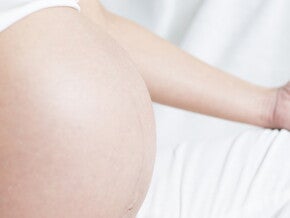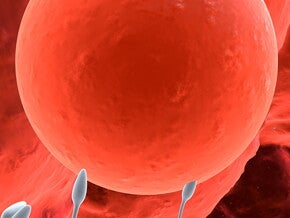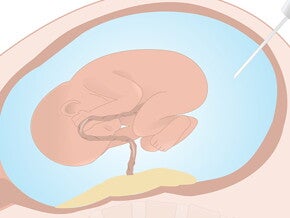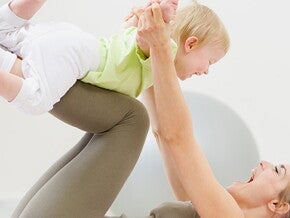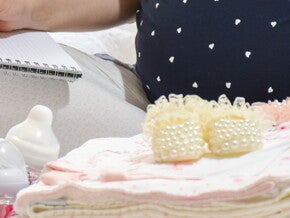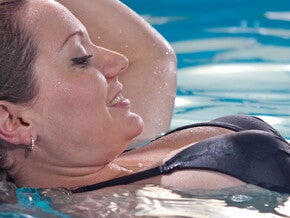
Third trimester
Increased weight gain and discomfort will limit your movements. A gradual transition to non-weight bearing exercises, alternating low impact exercises with a walking programme, may be preferable. Let your body dictate the changes to your exercise routine.
Abdominal muscles

The abdominal muscles stretch the most during pregnancy. Keeping them conditioned helps you to maintain good posture and avoid backache, assists in pushing out the baby during birth, and speeds up your recovery and the return of your figure.
The two bands of the rectus abdominis muscle frequently become separated. Exercises must be adapted to trengthen the bands of muscle, rather than increase the separation.
Checking for the separation of your rectus abdominis muscles
- Lie on your back with your knees bent.
- Press the fingers of one hand into the area above the belly button.
- Slowly raise your head and shoulders.
- The muscles will tense, allowing your fingers to feel any gap. A gap of more than two fingers wide requires modified abdominal exercise.
If there is separation of the muscles, the underlying soft tissue bulges through the gap when you raise your head and shoulders.

Modified abdominal exercise
- Lie on your back with your knees bent.
- Cross your hands over your abdomen and place them on either side of your waist.
- Breathe in.
- Lift your head up as you breathe out.
- At the same time pull the abdominal muscles toward the midline with your hands.
- Slowly lower your head.
Pelvic muscles
The pelvic floor muscles support the expanding uterus. It is important to improve the tone of these muscles during pregnancy and maintain it throughout your lifetime. A healthy, supple pelvic floor will alleviate constipation, piles and poor circulation to the perineum, improve bladder control and sexual function, and allow more distension of the vagina during delivery.
- To check the strength and location of your pelvic floor muscles, try stopping the flow of urine in midstream – not to be done routinely!
These muscles respond quickly to regular exercise.

Pelvic floor exercise (Kegel exercise)
Alternately tighten and relax the pelvic and vaginal muscles.
- Do this frequently throughout the day.
- You can do this anywhere, anytime and in any position.
- Try holding contractions for 2–3 seconds before releasing tension.
Perineal massage
Perineal massage is the gentle stretching and massaging of the skin and tissues around the vagina and perineum. During the last weeks of pregnancy, it is helpful to prepare the perineum for birth by enhancing elasticity and suppleness, and may well reduce your risk of a perineal tear or episiotomy (perineal cut). Women with previous cuts or tears of the perineum will notice that the scar tissue is not as elastic as the rest of the perineum, so concentrate on that area.Do not massage the perineum if you have an active herpes lesion or any other vaginal infection, because this may spread the infection. Avoid massaging around the urethra because you are more susceptible to urinary tract infection during pregnancy.
Massaging the perineum is easier if you stand with one leg up on the edge of the bath after you have bathed. Some women find squatting easier. Time, sensitivity and patience are needed when doing this.
Try a once-daily treatment from around 36 weeks of pregnancy. The first time you attempt perineal massage may seem a bit strange as you try and manoeuvre around your bump. A warm bath before you begin will help you relax and will ensure that your perineum is soft and pliable. You may need a mirror to guide you the first few times, or ask your partner to participate.
Sweet almond or grape seed oil, or your own body secretions, are good lubricants. Lubricate your fingers before inserting them 3–4 cm inside your vagina, using a downward pressure, then press your perineum to the sides. Gently stretch the opening until you feel a slight burning or tingling. Maintain the pressure for about 30–60 seconds and then release. Start with two fingers and then gradually increase the pressure and the number of fingers, eventually using three or four. You may find that using your thumbs is easier. A kneading action with the index finger and thumb is also effective. In the beginning your perineum will feel tight, but with time and practice the tissues will relax and stretch. Continue the gentle massage, and maintain the stretch and pressure for 3–4 minutes. Over time you will build up a tolerance to the slight burning, tingling sensation, which will be of enormous benefit during the pushing stage of labour.



